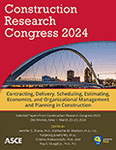Quantifying the Impact of COVID-19 on the Transportation Construction Industry Using Regime Switching Models
Publication: Construction Research Congress 2024
ABSTRACT
COVID-19 has unprecedentedly impacted the transportation construction industry. Highway agencies are facing great challenges posed by the pandemic, including labor shortage, project delays, and increasing costs. The research objective of this paper is to quantify effects of COVID-19 on US transportation construction material prices. Markov switching regression and causality inference were used to empirically analyze the relationship between transportation construction material prices and indicators monitoring different aspects of COVID-19 effects and government response. The results reveal the lasting adverse impact of the pandemic on volatility in material prices. The extent of recovery was highly dependent on the degree of economic support and lockdown measures. Causality test confirms that stringency index, economic support, and number of confirmed cases are leading indicators of transportation construction material prices. This research contributes to the body of knowledge by (1) establishing a statistical method for quantifying impact of COVID-19 on transportation construction industry, and (2) analyzing material prices in transportation construction industry before, during, and after COVID-19. It is anticipated that the results will help policymakers grasp the impact of COVID-19 on transportation construction activities and design more effective policies to respond to future pandemics.
Get full access to this article
View all available purchase options and get full access to this chapter.
REFERENCES
ARTBA (American Road and Transportation Builders Association). (2023). “National Commodity and Material Prices for Transportation Construction.” American Road and Transportation Builders Association. Accessed August 18, 2023. https://www.artba.org/economics/materials-dashboard/.
AGC (Associated General Contractors of America). (2020). “AGC Coronavirus Survey Southern Results (June 9-17).” Accessed August 18, 2023. https://www.agc.org/sites/default/files/2020_Coronavirus_EighthEdition_South.pdf.
AGC (Associated General Contractors of America). (2022). “Construction Workforce Shortages Risk Undermining Infrastructure Projects as Most Contractors Struggle to Fill Open Positions.” Accessed August 18, 2023. https://www.agc.org/news/2022/08/31/construction-workforce-shortages-risk-undermining-infrastructure-projects-most-contractors-struggle-0.
Alsharef, A., Banerjee, S., Uddin, S. J., Albert, A., and Jaselskis, E. (2021). “Early impacts of the COVID-19 pandemic on the United States construction industry.” Int. J. Environ. Res. Public Health, 18(4), 1559.
Ataei, H., Becker, D., Hellenbrand, J. R., Mehany, M. S. H. M., Mitchell, T. E., and Ponte, D. M. (2021). COVID-19 pandemic impacts on construction projects.
Baral, A., Liang, Y., Li, M., Gonzalez, M., Shahandashti, M., and Ashuri, B. (2022). “Impact of COVID-19 on the Diversity of the Construction Workforce.” Nat. Hazard. Rev., 23(3), 04022015.
Chow, G. C., and Niu, L. (2015). “Housing prices in urban China as determined by demand and supply.” Pacific Economic Review, 20(1), 1–16.
Deep, S., Joshi, R., and Patil, S. (2022). “Identifying the Contractor’s core competencies in post-COVID-19 scenario: Developing a survey instrument.” Engineering, Construction and Architectural Management.
Ebekozien, A., and Aigbavboa, C. (2021). “COVID-19 recovery for the Nigerian construction sites: The role of the fourth industrial revolution technologies.” Sustainable Cities Soc., 69, 102803.
Ebekozien, A., Aigbavboa, C., and Aigbedion, M. (2021). “Construction industry post-COVID-19 recovery: Stakeholders perspective on achieving sustainable development goals.” Int. J. Construct. Manage., 1–11.
Granger, C. W. (1969). “Investigating causal relations by econometric models and cross-spectral methods.” Econometrica: journal of the Econometric Society, 424–438.
Hale, T., Angrist, N., Goldszmidt, R., Kira, B., Petherick, A., Phillips, T., and Tatlow, H. (2021). “A global panel database of pandemic policies (Oxford COVID-19 Government Response Tracker).” Nat. Hum. Behav., 5(4), 529–538.
Hamilton, J. D. (1989). “A new approach to the economic analysis of nonstationary time series and the business cycle.” Econometrica: Journal of the econometric society, 357–384.
Kim, S., Makhmalbaf, A., and Shahandashti, M. (2022). “Diagnosing and quantifying post-COVID-19 fluctuations in the architecture billings indices.” Engineering, Construction and Architectural Management.
King, S. S., Rahman, R. A., Fauzi, M. A., and Haron, A. T. (2022). “Critical analysis of pandemic impact on AEC organizations: The COVID-19 case.” J. Eng., Des. Technol., 20(1), 358–383.
Obando, S. (2022). “Construction’s supply chain outlook: more shortages, price hikes ahead.” Construction Dive. Accessed August 18, 2023. https://www.constructiondive.com/news/supply-chain-construction-building-materials-price-2023/636442/.
Panwar, R., Pinkse, J., and De Marchi, V. (2022). “The future of global supply chains in a post-COVID-19 world.” California Management Review, 64(2), 5–23.
Simonson, K. (2023). “U.S. Construction Outlook: Rotation or Retreat?.” The Associated General of Contractors of America. Accessed August 18, 2023. https://www.agc.org/sites/default/files/users/user21902/Construction%20trends%20%26%20outlook_.pdf.
Song, Y., and Woźniak, T. (2020). “Markov switching.”.
Taghizadeh-Hesary, F., Yoshino, N., and Phoumin, H. (2021). “Analyzing the characteristics of green bond markets to facilitate green finance in the post-COVID-19 world.” Sustainability, 13(10), 5719.
USA Spending. (2023). “The Federal Response to COVID-19.” Accessed August 18, 2023. https://www.usaspending.gov/disaster/covid-19?publicLaw=all.
Yang, Y., Chan, A. P., Shan, M., Gao, R., Bao, F., Lyu, S., and Guan, J. (2021). “Opportunities and challenges for construction health and safety technologies under the COVID-19 pandemic in Chinese construction projects.” Int. J. Environ. Res. Public Health, 18(24), 13038.
Zhao, J., Wang, J., and Dong, K. (2022). “The role of green finance in eradicating energy poverty: ways to realize green economic recovery in the post-COVID-19 era. (2022).” Economic Change and Restructuring, 1–29.
Zhang, Y., and Fricker, J. D. (2021). “Quantifying the impact of COVID-19 on non-motorized transportation: A Bayesian structural time series model.” Transport policy, 103, 11–20.
Zevin, A., and Rubin, D. (2021). “2022 Forecast: Industry on Slow Path to Recovery.” Engineering News-Record. Accessed August 18, 2023. https://www.enr.com/articles/53037-forecast-industry-on-slow-path-to-recovery.
Information & Authors
Information
Published In
History
Published online: Mar 18, 2024
Authors
Metrics & Citations
Metrics
Citations
Download citation
If you have the appropriate software installed, you can download article citation data to the citation manager of your choice. Simply select your manager software from the list below and click Download.
